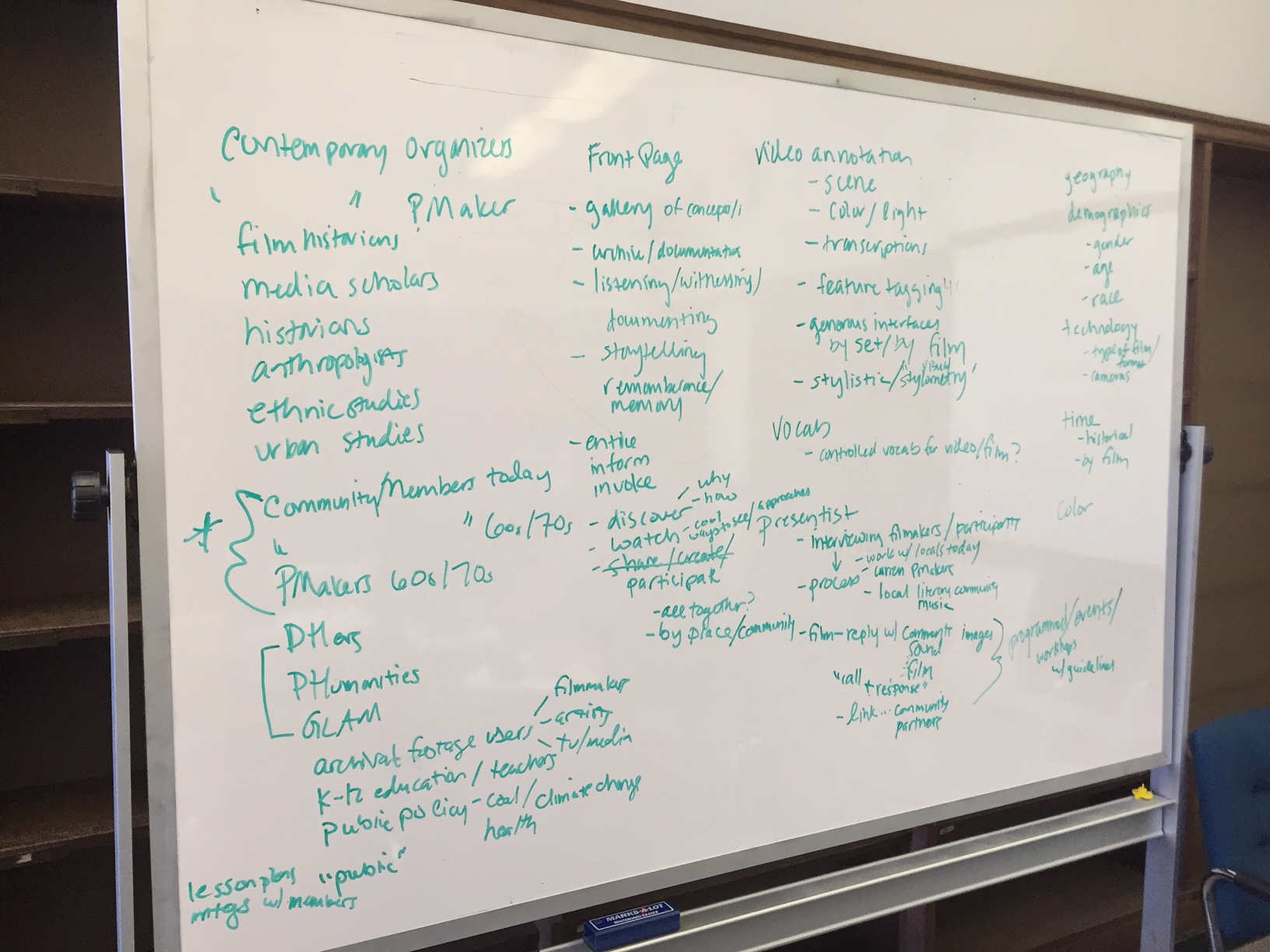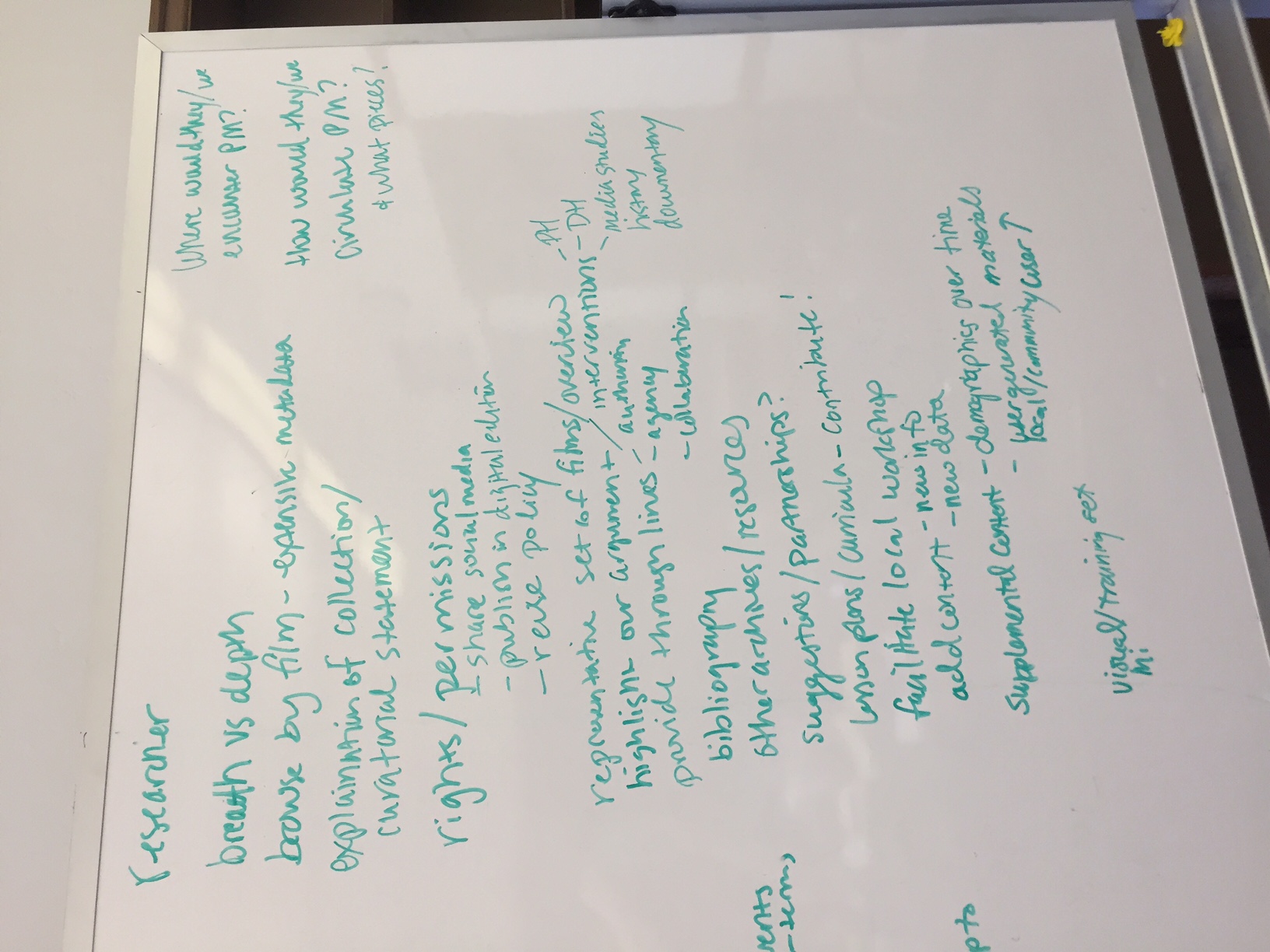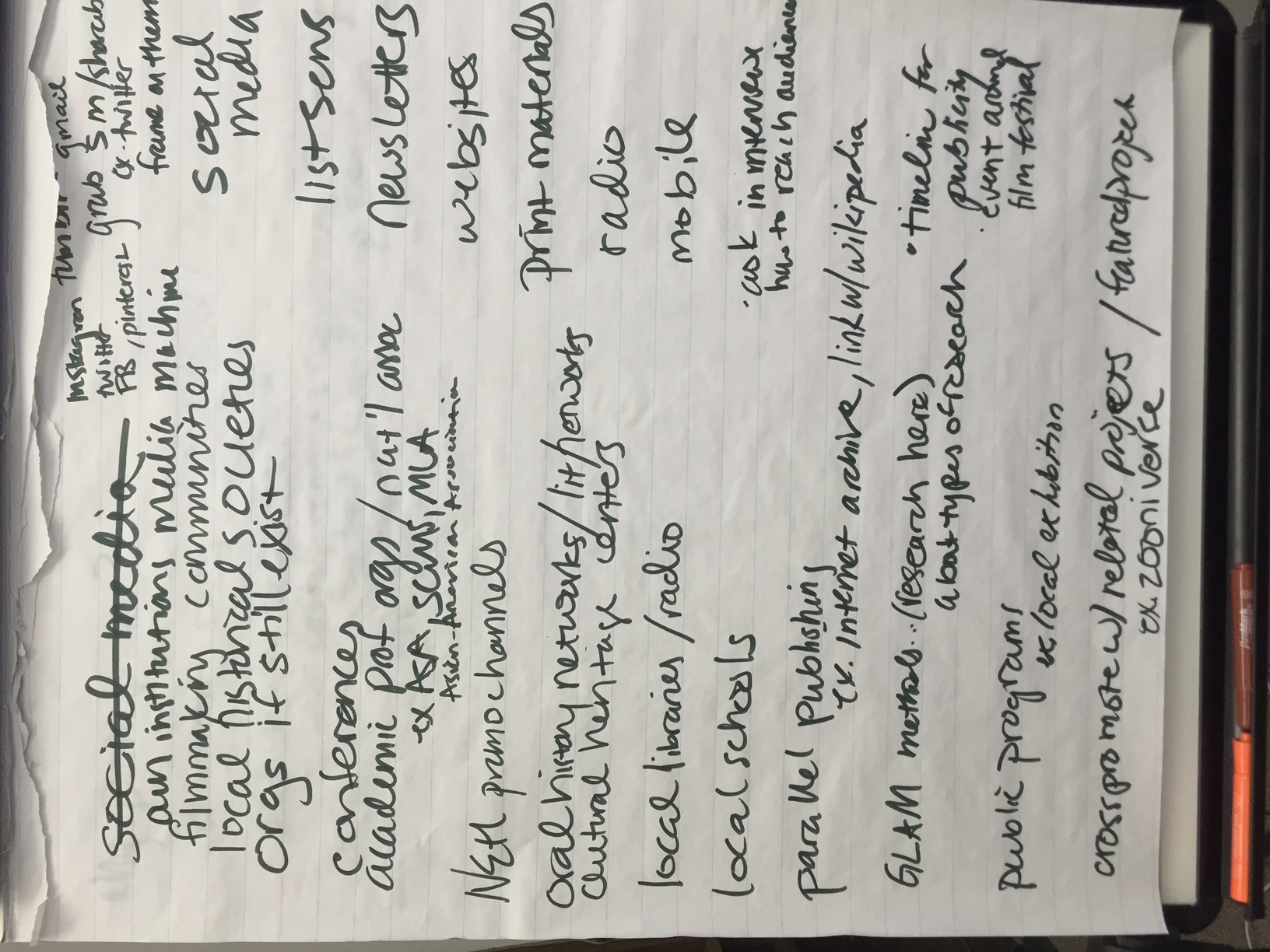Meeting 1: 2016.05.09 - nolauren/pmproject GitHub Wiki
What is PM?
- Working with communities to create media (Len Kammerling, etc)
- Teaching people to use equipment and make films (workshop)
- Community members controlling the camera on their terms (resource)
- People going out and filming people them trying to capture the local (ethnographic/ folk)
- all film? Signal if we are just doing all film to start with or if we are extending to other media
Appalshop (Grace)
- Mountain Community Television
- Digitize extra film/ outtakes
- audio tracks/ wild tracks
Community Film Workshop of Chicago
- films
- photographs of the workshop
- Margaret Caples -> interview
Young Filmmakers Foundation
- NYPL send films
- Suzan Seig films
Captioning and transcription of the films.
Parallels between DH and this project. We don't want to take this stuff from you. We want to work with you to produce this kind of thing yourself. Build archive at the community level. Ethically as a way to do it. Ex. Work with people in Chicago to help them sustain the project. Modularity - Sliding array of things people can do. Take into account the position each group is in and develop different ways to engage and levels of support. Feminist approaches to archives - stewardship, authority, co-creation. Developing co-creation and workshops develop them themselves. Is there a community media operation now that would like to partner? Ex. Partnership with students from NYU Moving Image Preservation program. Create such a program at UVa and URichmond. Reach out to Molly at UR about this kind of program. Also look to models like Home Movie Day.
Dartmouth - Media Ecology Project - Open-linked data, W3c standards
- Taxonomy vs folksonomies .. as open research question
- Primary interested in linked data. Discoverable from there.
- Partnering with AMIA and SCMS
Who is audiences?
Otisville/ Middletown Girls Club - Incarcerated youth in NY.
Appalshop/ Mountain Community Television - Family and community history on film. New York City/ Film Clubs/ YFF
Community Film Workshop of Chicago - Connected to media industry. Producing prominent set of media makers. Have early training films.
Alaska Yupik - Well connected today and very wired. Family and community history on film. Collaborative community filmaking process. Dispersed authority.
How do we get people to these existing archives and evoke some kind of participation with the archive? Trying to identify perhaps local communities/ academic departments. Curricula that connect people to the archive and prompt response. Ex. Higher ed/ classrooms/ community centers
What are the questions want to ask of the material already? What kind of research questions do people want to answer? What kind of research do people want to do once they see an interface?
Ex. Local issues addressed/shaped by access to materials. ie. material around coal
- Curriculum/ University
- Local Community/ Community in the archive
- Apppalshop
- Media Historians/ scholars/ researchs
- Questions about media
Who will look at them across the archive? In juxtaposition? questions of media, authority, and power... ideas of circulation of info/ democracy ... grappling with same issues in a different ecology/ context... working through and being stumped by them ... how do we represent ourselves to the world and take back that power of creating the image they create? ... issue of circulation as core ... very different histories behind each of these communities... and then this thing that gives their answer to how to navigate their history, produce community, Who will look at them by each archive?
Barriers to participation / tell stories
- technological
- translation of culture
- different methodologies for different communities ... spectrum of sharing, not just unfettered sharing. It could be very important to be intentional about sharing. Ex. Certain communities want to share with a more specific one. Think of strategies to that more thoughtfully. Find room between radical transparency and not sharing.
Inform about current participatory media.
Inform local issues. Lodging new materials that circulate within local community.
With LOD, can make it findable.
Credits as important to capture and document. Attach terms to the content in a way that opens up new access, narratives, stories. Metadata - crowdsourced... allows people to add metadata.
Interfaces - either specialized for specific research or open and accessible to everyone. Visual Interface Design for Digital Cultural Heritage - Rucker, Sinclair Instead of privileging of a search, instead create a browse interface. Expose all the affordances. See all that is there and then drill down. Book has great prototypes. Rich browsing with feminist design.
Audiences
- contemporary organizers
- contemporary participatory makers
- film historians
- media scholars
- historians
- anthropologists
- ethnic studies
- urban studies
- community members today
- community members in the 60s and 70s
- participatory media makers 60s and 70s
- DH community
- PH community
- GLAM
- Archival footage users: filmmakers, archivests, TV, media
- K-12 education and teachers
- public policy: coal, climate change, health
- general "public"
Allow users to search across different aspects such as geography and demographics (gender, age, race). Organize by technology (type of film, cameras), as well as time.
Analyze colors, and tones in B&W. Split out by scenes and create "generous" interfaces on top of it.
Video annotation: scene, color/light, transcripts, feature tagging, generous interfaces by set and by film. Different stylistic approaches; how to describe these? Visual stylometry.
Vocabulary: controlled vocab for video/film?
See: http://histography.io/ and http://gravitron.com.au/tate/tate.html
Idea: Focus on design for community members / makers from today and from the past. Academic ideas will be embedded in the larger design and the DH/PH in the interface. Public will come along with a nice interface. Larger academic questions can be framed with external documents.
Presentist: interviewing filmmakers / participants, ask about the process. Film and reply w/ comments and images, sound, film. "Call + response". Will need to be curated; worthwhile doing but requires a lot of work. Perhaps off-load to specific communities that already exist (twitter, facebook, internet archive) and link to it? Programmed / events / workshops with guidelines.
Front page: gallery of concepts. Archive, documentation. Listening, witnessing, documenting. Storytelling. Remembrance and memory. Participate! All together? By place/community. Possible tension to be aware of: how do we privilege inter versus intra community links.
Example users

Appalshop community member
- Wants to find the appalshop collection.
- Figure out scope of the collection: how many videos are there? Find videos by local geography town/locality. * Contribute new/additional information: geographic, people depicted or involved, stories, local taxonomy and metadata.
- Watch videos and share with friends and family.
- Geography and naming. Area specific maps? Deep mapping.
- Adding historical context and scaffolding. Newspapers, related material,
- Recently added material. Call to action with a clear easy to access prompt to participate.
Researcher
-
breadth versus depth issue.
-
database of all the films; browse by a number of facets.
-
explanation of the curatorial process
-
rights management, both general and specific. social media versus publish and digital collections re-use.
-
representative films / overview of the collections
-
provide through lines: authoritative, agency, collaboration
-
bibliography
-
links to other archives and resources
-
highlight our scholarly argument; framing the project; links to internal documentation; break by PH, DH, media studies, history, documentary
-
Call and response method:
-
Ways for people to submit items for bibliography, archives and resources, partnerships, lesson plans and curriculum
-
facilitate work with local workshop
-
Way for people to add Analytics, health analysis, demographics, info about local site and new local data, supplemental content—like demographics
-
Way access local community user provided data, materials (like family tree, etc)
-
Visual moving image training set—way for us to collect info for deep seeing while user has fun
Also work for local community user
Where would they use or encounter PM? How would they/ we circulate PM and what pieces?
Where will people find out about PM:
- Filmmaking communities
- Local historical societies
- Organizations themselves if still exist
- Through social media
- Conferences
- Academic prof. associations
- NEH promo channels
- Through listservs, newsletters, websites, print materials
- Oral history networks
- Cultural heritages centers
- Local libraries, radio
- Through all above plus radio
- parallel publishing (internet archive, flicker etc)-link with wikipedia
- GLAM methods (Ask Cathy to help)
- Local schools
- Public programs Ex. Local exhibition
- Cross-promote with related projects, featured project (ex. Zooniverse), own institutions
- Question of when/how to start publicizing
- Stages of building, grant getting, etc
- Could build event around soft or hard launch
- Grab SM, sharable media: Instagram, twitter, FB, pinterst, tumblr
- Frame what we mean by participatory
Digital Participation: What kinds of engagement? What actions will users engage in? How do we incentivize and sustain participation? What are many reasons people participate? What are their rewards for participating?
- Document story: family, local history
- Does participate mean encouraging people to participate broadly: i.e. making their own media and then sharing news of it with us? versus participate meaning meaning more specifically engaging with our site?
- Push and pull meaning connecting across past/present divide. Ex. Working with Appalshop connect with contemporary project
- Could we offer set of frameworks, connect to workshops that would encourage, could we create public humanities programming around place-based versions of is there a way to teach people to think about making media in thoughtful, enable, training people to do this stuff, to work with the media of the day (as film was in one moment)participatory media making today, stuff could be made today with so much more meta data, meaningful way, how circulate and archive it?
- Grounding in local as theme
- Ways to make tasks like tagging into fun, participatory practice
- Thinking about multiple sites of engagement
- Sharing content out with other people is another form of participation
- Can we track and encourage that kind of use
- Encouraging decentralized, participation rich experience/ project
- Building in ways for us to encourage, enable reporting of people’s sharing activities
- Structure site in way would optimize people being able to share materials
How do we archive, keep track of conversations about PM happening on social media? Creating a to do list for project?
Content: What additional content/ materials need to be created and/or collected?
Timeline:
- Be ready to apply for NEH grant with draft May 1, 2017
- Design documents
- Clearer idea of public audience
- Better articulate project evaluation and testing
- [exact product we need by end of grant time—see website]
- need to get info to Jeremy about information, type of content will need on a community group page


